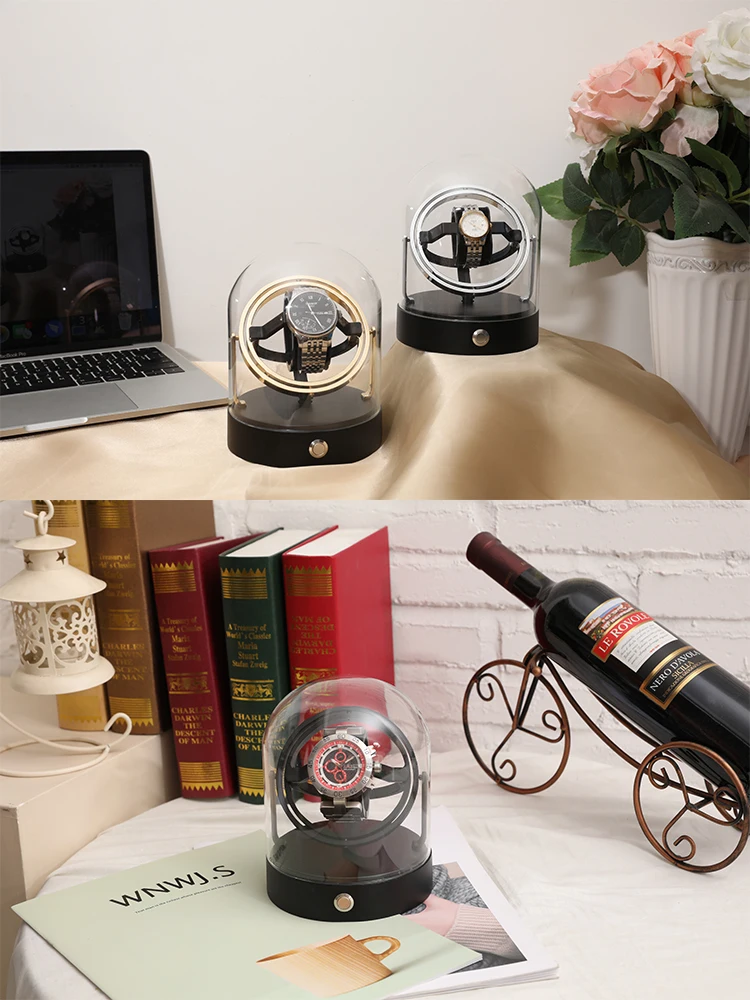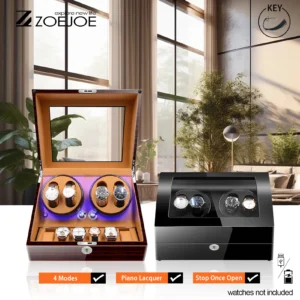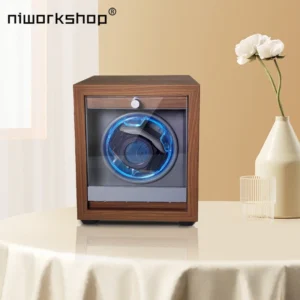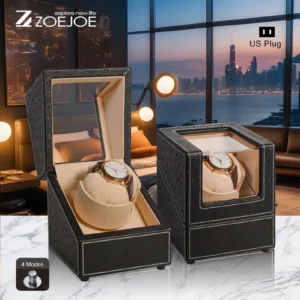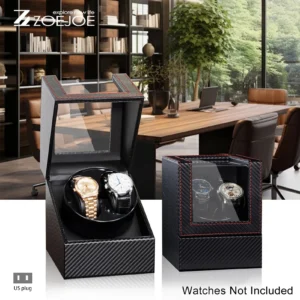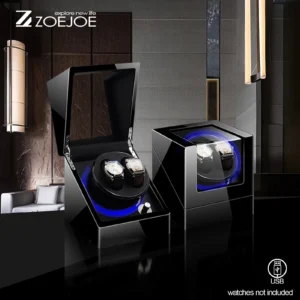Introduction: The Critical Heart of Watch Winder Performance
When it comes to automatic watch winders, the motor is unquestionably the most critical component determining the device’s overall longevity and performance. This small mechanical heart powers every rotation, ensuring your treasured timepieces remain wound and ready for wear.
Motor quality directly impacts several crucial aspects of a watch winder’s performance:
- The precision and consistency of rotation patterns necessary for proper watch maintenance
- The overall safety of your valuable timepieces during the winding process
- The long-term reliability of your winder as an investment
For watch enthusiasts who have invested significantly in their collections, understanding the mechanics behind these devices becomes essential. A quality watch winder motor should reliably operate for 5-10+ years, while inferior components may fail much sooner.
The price difference between entry-level winders (starting around $100) and premium models (exceeding $5000) largely reflects the quality of internal components—particularly the motor. Understanding watch winder motor specifications and capabilities will help you make informed decisions when selecting these essential tools for your collection.
Types of Watch Winder Motors and Their Durability Characteristics
Not all watch winder motors are created equal. The type of motor in your winder significantly influences its performance, noise level, and expected lifespan.
Japanese Motors (Mabuchi)
Japanese Mabuchi motors represent the industry’s middle ground, offering reliable performance at a reasonable price point.
- Reliability Profile: Consistent performance with good quality control
- Noise Level: Moderate, typically audible but not disruptive
- Typical Lifespan: 5-8 years with proper care
- Value Proposition: Excellent balance of performance and cost
Swiss/German Precision Motors
The gold standard in watch winder motor technology comes from European engineering.
- Premium Characteristics: Exceptional build quality with precision components
- Operational Sound: Nearly silent operation, often below ambient room noise
- Extended Lifespan: 10-15+ years is common with proper maintenance
- Price Point: Significantly higher, but with proportional quality benefits
Budget Motors
Entry-level watch winders utilize more basic motor systems.
- Quality Range: Highly variable, from acceptable to problematic
- Durability Issues: Common failure points include plastic gears and inadequate lubrication
- Expected Lifespan: Typically 2-5 years, sometimes less with heavy use
- Cost Consideration: Lowest initial investment, but may require earlier replacement
Technical Differences Impacting Durability
The construction style of motors directly influences their lifespan:
Brushless vs. Brushed Design: Brushless motors eliminate the friction-causing components that wear out in traditional brushed motors, resulting in substantially longer operational life. Most premium winders feature brushless technology.
Gear Systems vs. Belt-Driven: Gear-driven systems provide precise control but can wear over time. Belt-driven mechanisms offer smoother operation with fewer potential failure points, though belts themselves eventually require replacement.
Torque Capabilities: Higher-quality motors provide consistent torque regardless of watch weight, while budget options may struggle with heavier timepieces, leading to premature wear.
Different types of motors in watch winders offer varying benefits depending on your collection needs. For collectors concerned about ambient noise, understanding quiet watch winder technology becomes particularly important. Browse our selection of automatic watch winders to compare different motor technologies and find the perfect match for your collection.
Key Engineering Factors That Determine Motor Longevity
Understanding the engineering behind watch winder motors reveals why some last significantly longer than others. Several key factors contribute to motor durability:
Material Quality of Internal Components
The materials used in critical components like bearings, gears, and windings directly impact longevity:
– Precision steel bearings outlast brass or plastic alternatives
– Metal gears provide superior durability compared to nylon or plastic versions
– Copper windings with proper insulation resist heat damage better than aluminum alternatives
Circuit Board Design and Power Management
Advanced circuit designs protect the motor from electrical damage:
– Voltage regulation prevents power fluctuations from damaging sensitive components
– Thermal protection circuits prevent overheating during extended operation
– Soft-start technology reduces wear from abrupt starts and stops
Heat Dissipation Engineering
How a motor manages heat directly correlates with its lifespan:
– Heat sink implementation draws heat away from critical components
– Ventilation channels allow proper airflow around motor components
– Thermal-resistant materials prevent warping or degradation under heat stress
Shock Absorption and Vibration Control
Quality winders incorporate features to minimize vibration:
– Rubber mounting points isolate the motor from the housing
– Balanced rotors reduce operational vibration
– Strategic weight distribution minimizes stress on bearings
Lubrication Systems
Superior motors employ advanced lubrication approaches:
– Sealed bearing systems maintain lubrication for years without service
– Self-lubricating components reduce maintenance requirements
– High-grade lubricants resist breakdown from continuous operation
Quality engineering fundamentals found in high-performance winder motors make a substantial difference in operational life. For collectors seeking the ultimate in durability, exploring luxury watch winder options provides access to the most advanced motor technologies available.
How Usage Patterns Affect Your Watch Winder’s Motor Life
The way you operate your watch winder significantly impacts how long its motor will last. Understanding these usage factors helps you maximize the lifespan of your investment.
Continuous vs. Programmed Operation
Allowing your winder to operate continuously places constant strain on the motor:
- Programmed Cycles: Setting your winder to operate in defined intervals with rest periods can extend motor life by 30-50%
- Rest Periods: Even brief 1-2 hour breaks between winding cycles dramatically reduce cumulative heat buildup and wear
- Night Mode: Some premium winders offer reduced operation during overnight hours, providing natural rest periods
Weight Load and Multiple Watches
The physical stress on a motor increases with the weight it must turn:
- Heavy watches require more torque, creating additional strain
- Multi-watch winders distribute weight unevenly if not fully loaded
- Exceeding recommended weight limits accelerates bearing and gear wear
Pro Tip: Match your watch weight to the winder’s rated capacity. Heavier watches should be placed in winders with stronger motors designed for higher torque requirements.
TPD (Turns Per Day) Settings
The number of daily rotations directly correlates with motor wear:
- Higher TPD settings (above 1000) significantly increase mechanical wear
- Many watches maintain power reserve effectively at 650-800 TPD
- Setting TPD to the minimum effective level for your specific watches extends motor life
Understanding proper TPD settings for watch winders helps balance optimal watch maintenance with motor preservation. Most quality watches don’t require the maximum TPD settings that many collectors mistakenly use.
Power Source Considerations
The quality of your power supply impacts motor performance and longevity:
- Dedicated AC adapters provide more stable power than universal adapters
- Battery operation can sometimes introduce inconsistent voltage
- Power fluctuations from poor-quality adapters can damage motor control circuits
Environmental Factors and Their Effect on Motor Performance
Your watch winder’s surroundings play a crucial role in determining how well its motor will perform over time.
Temperature Impacts
Temperature fluctuations can significantly affect motor components:
- Optimal operating range: 60-75°F (15-24°C)
- Excessive heat accelerates lubricant breakdown and can deform plastic components
- Cold environments increase motor strain during startup and can affect lubricant viscosity
Humidity Concerns
Moisture is the enemy of electronic components and precision mechanics:
- Ideal humidity range: 40-60%
- High humidity promotes corrosion of metal components and circuit boards
- Very low humidity increases static electricity risks to sensitive electronics
Dust Accumulation
Airborne particles present a serious threat to motor longevity:
- Dust acts as an abrasive between moving parts
- Sealed motor designs provide superior protection against contamination
- Placing winders in dusty areas dramatically shortens motor life
Vibration and Stability
External vibrations compound the normal operational movement:
- Unstable surfaces transmit vibrations that stress bearings
- Nearby appliances or equipment can create resonant vibrations
- Solid, level surfaces provide the ideal foundation for operation
Sunlight Exposure
Direct sunlight damages more than just watch finishes:
- UV radiation degrades plastic components over time
- Solar heat creates localized hot spots that stress materials
- Temperature fluctuations from intermittent sun exposure cause expansion/contraction cycles
Explore our collection of watch winders designed with various environmental protections to suit your specific placement needs.
Warning Signs of Motor Deterioration: When to Take Action
Recognizing the early symptoms of motor issues can prevent more serious problems and potentially save your investment. Here are key warning signs to monitor:
Audible Indicators
Your ears can detect problems before they become critical:
- Grinding or Clicking: Indicates potential gear damage or bearing failure
- Increasing Volume: Motors typically get louder as they deteriorate
- Irregular Sound Patterns: Healthy motors maintain consistent operational sounds
Performance Indicators
Watch for changes in how your winder operates:
- Inconsistent Rotation: Varying speeds or irregular movement patterns
- Hesitation or “Stuttering”: Momentary pauses during what should be smooth rotation
- Mid-Cycle Stoppage: Motor stops before completing programmed rotations
- Unusual Heat: Excessive warmth from the motor housing area
- New Vibrations: Development of tremors or shaking not previously present
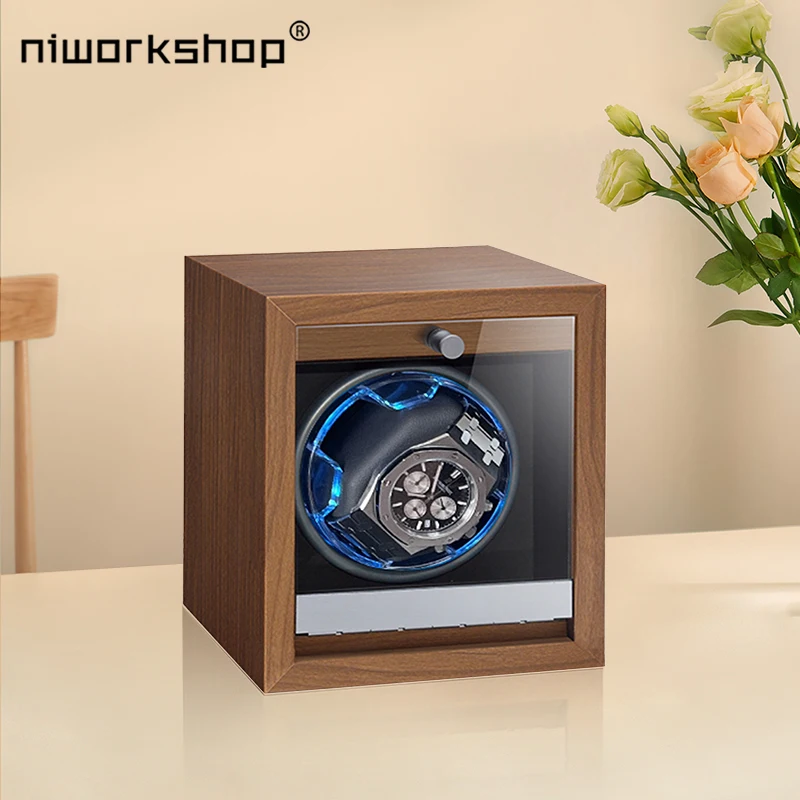
Timeline and Progression
Understanding how problems typically evolve helps determine urgency:
- Initial symptoms often appear intermittently before becoming constant
- Many motor issues progress gradually over weeks or months before complete failure
- Early intervention at the first signs of trouble can often extend operational life
Testing for Problems
Simple diagnostic checks can confirm suspected issues:
- Listen closely in a quiet room with the winder placed on a hard surface
- Compare current sound levels to when the unit was new
- Test with different watches to determine if weight is a factor
- Run the winder through different programs to identify pattern-specific problems
Essential Maintenance Practices to Extend Motor Lifespan
Proper maintenance can significantly extend your watch winder’s motor life. Following these practices helps protect your investment:
Regular Cleaning Protocol
Keep your winder free of dust and debris:
- Power off and unplug the unit before cleaning
- Use compressed air to gently blow dust from ventilation areas
- Wipe external surfaces with a soft, slightly damp microfiber cloth
- Never use liquid cleaners near motor vents or controls
- Schedule monthly cleaning for optimal performance
Power Management Best Practices
Protect your winder from electrical issues:
- Use surge protectors to guard against power fluctuations
- Avoid frequent on/off cycles which stress startup components
- Follow proper shutdown procedures recommended by the manufacturer
- Consider power conditioning devices in areas with unstable electricity
Optimal Placement Guidelines
Position your winder for maximum protection:
- Place on solid, level surfaces away from edges
- Maintain at least 2 inches (5cm) of clearance around ventilation areas
- Keep away from direct sunlight and heat sources
- Avoid high-humidity locations like bathrooms or damp basements
- Shield from areas with significant dust or airborne particles
Programmed Rest Periods
Allow your motor regular breaks:
- Program your winder to operate 12-18 hours daily rather than continuously
- Set TPD to the minimum effective setting for your specific watches
- Consider timers for winders without built-in programming capabilities
- Schedule longer rest periods (24-48 hours) monthly
Understanding watch winder motor power requirements helps you implement proper electrical maintenance practices that protect these sensitive components.
Motor Quality Indicators When Purchasing a Watch Winder
When investing in a new watch winder, several key indicators can help you assess motor quality before purchase:
Key Specifications to Evaluate
Look for these technical details in product descriptions:
- Motor Type: Japanese, Swiss, or German motors generally indicate higher quality
- Brushless Design: Indicates superior longevity compared to brushed motors
- Rotation Patterns: More sophisticated pattern options suggest advanced motor control
- Power Consumption: Lower power usage often correlates with efficient motor design
- Weight Capacity: Higher rated capacity indicates stronger, more durable motors
Warranty Indicators
The warranty reveals manufacturer confidence:
- Length of Coverage: 2+ years suggests confidence in motor durability
- What’s Covered: Comprehensive motor coverage indicates quality construction
- Exclusion Clauses: Fewer exclusions generally means better components
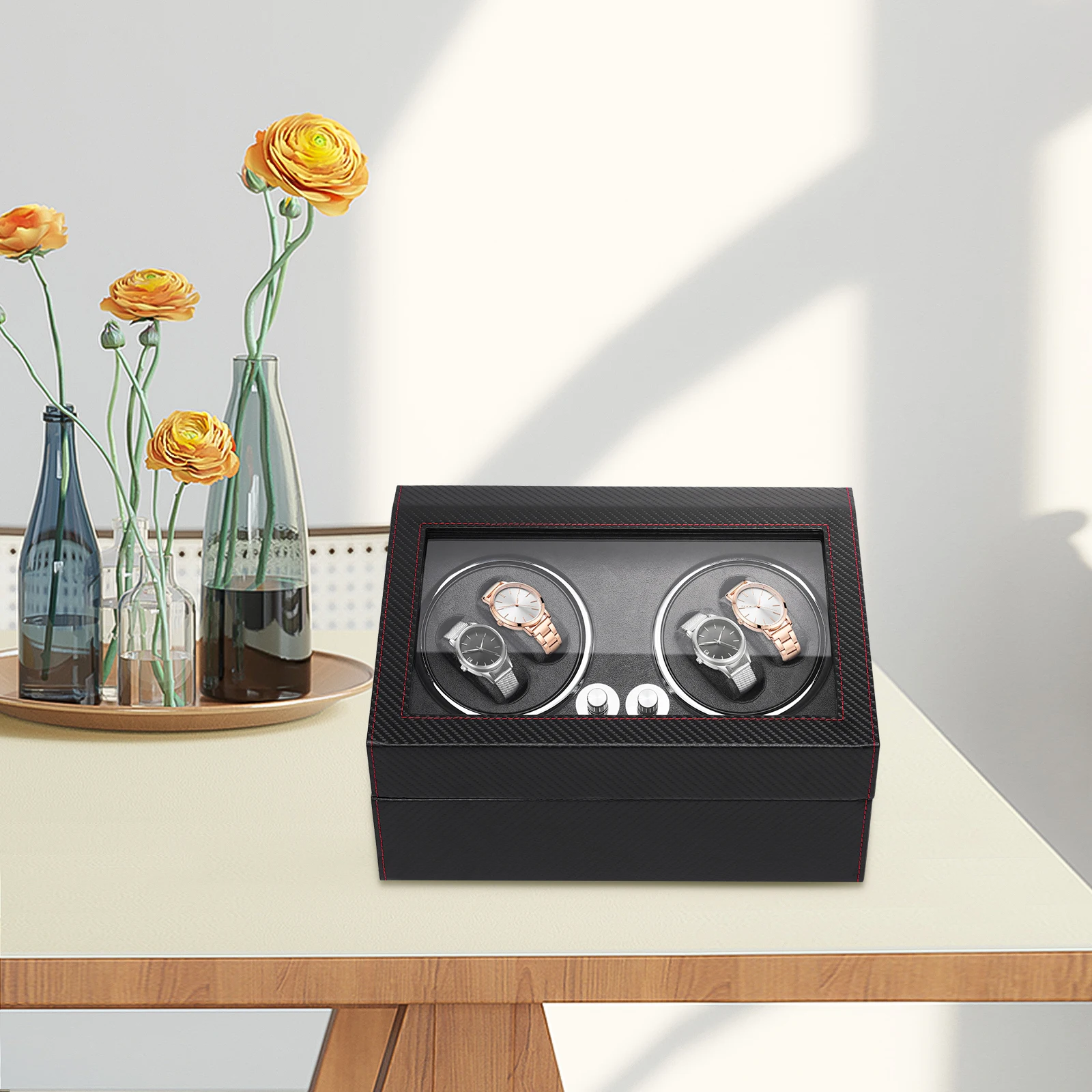
Noise Level Assessment
Sound output often reflects build quality:
- Decibel Ratings: Lower numbers indicate precision engineering
- Sound Quality: Smooth humming is preferable to mechanical clicking
- Customer Reviews: Pay attention to mentions of noise in user feedback
Questions to Ask Before Purchasing
Get answers to these critical questions:
- “What type of motor is used in this specific model?”
- “What is the expected motor lifespan under normal use?”
- “Are replacement motors available if needed after warranty expiration?”
- “Does the winder include thermal protection or overload protection?”
Understanding watch winder warranty reliability helps you evaluate these important protection features. For those seeking balance between quality and capacity, our double watch winder collection offers options with various motor specifications.
Automatic Watch Winder, Luxury Watch Winder, Single Watch Box
$307.39 Select options This product has multiple variants. The options may be chosen on the product page4 Watch Winder, 6 Watch Box, Automatic Watch Winder
$512.31 Select options This product has multiple variants. The options may be chosen on the product pageAutomatic Watch Winder, Single Watch Winder, Wooden Watch Holder
$201.76 Select options This product has multiple variants. The options may be chosen on the product pageAutomatic Watch Winder, Leather Watch Travel Case, Single Watch Winder
$146.30 Select options This product has multiple variants. The options may be chosen on the product pageAutomatic Watch Winder, Double Watch Winder, Leather Watch Boxes
$147.60 Select options This product has multiple variants. The options may be chosen on the product pageAutomatic Watch Winder, Double Watch Winder
$206.18 Select options This product has multiple variants. The options may be chosen on the product page
Common Motor Issues and Troubleshooting Approaches
Even quality watch winders occasionally develop issues. Many common problems have simple solutions that don’t require professional intervention:
Power-Related Problems
When your winder won’t start or loses power:
- Check the power adapter connection at both ends
- Test the outlet with another device
- Inspect the adapter for damage or fraying
- Try an alternative compatible power source if available
Rotation Obstruction Issues
When rotation seems labored or inconsistent:
- Remove the watch and check for any visible obstructions
- Ensure the watch cushion is properly seated
- Verify the watch isn’t contacting the winder housing
- Check weight compatibility with winder specifications
Programming Challenges
For winders that aren’t following set programs:
- Reset to factory defaults following manufacturer instructions
- Re-enter programming carefully, confirming each setting
- Check if battery backup (if applicable) needs replacement
- Look for firmware update options on newer digital models
Noise Resolution
For winders developing unusual sounds:
- Place on different surfaces to rule out environmental vibration
- Check for loose components or foreign objects
- Listen carefully to locate the specific source of noise
- Apply a drop of appropriate lubricant to external moving parts if recommended by manufacturer
Understanding how much electricity watch winders use can help troubleshoot power-related issues. For collectors with multiple timepieces, our 4-watch winder collection offers reliable solutions with straightforward troubleshooting.
Enhanced Protection: Supplementary Measures for Motor Preservation
Beyond basic maintenance, several additional steps can further extend your watch winder’s motor life:
Protective Accessories
Invest in these supplementary items for enhanced protection:
- Quality Surge Protectors: Prevent electrical damage from power fluctuations
- Precision External Timers: Control operation cycles beyond built-in programming
- Custom Dust Covers: Shield from environmental contaminants during inactive periods
- Humidity Control Solutions: Maintain optimal environmental conditions for electronic components
Operational Enhancements
These practices provide additional motor protection:
- Rotation Variation: Occasionally change direction settings to distribute wear evenly
- Scheduled Rest Days: Implement one day per week of complete rest
- Load Balancing: Rotate watch positions in multi-watch winders to equalize strain
- Seasonal Adjustments: Reduce operation during humid summer months in non-climate-controlled environments
Professional Services
Consider these professional options for premium winders:
- Periodic Motor Inspection: Some luxury brands offer preventative maintenance checks
- Professional Cleaning: Deep internal cleaning by qualified technicians
- Lubrication Service: Renewal of specialized lubricants at recommended intervals
Different watch winder rotation modes impact motor wear in various ways. Understanding these differences helps you implement the most protective operation patterns for your specific winder.
FAQ: Critical Questions About Watch Winder Motor Durability
Is it normal for my watch winder motor to make some noise?
Yes, most watch winders produce some operational sound. Quality varies significantly between models, with premium winders operating at whisper-quiet levels (under 30 decibels) while budget options may produce noticeable mechanical sounds. If your winder suddenly becomes louder, it could indicate developing issues requiring attention.
Can watch winder motors cause magnetization of watches?
No, properly designed watch winders do not create sufficient electromagnetic fields to magnetize watches. The motors are specifically engineered and shielded to prevent this issue. If a watch becomes magnetized while using a winder, the cause is likely external environmental factors rather than the winder itself.
Do battery-operated winders have more reliable motors than plug-in models?
Not necessarily. The power source has less impact on reliability than the quality of the motor itself. However, battery-operated models may provide more consistent voltage without power grid fluctuations. The trade-off is the need for battery replacement and potentially lower torque capabilities.
How often should I expect to replace my watch winder?
With proper care, a quality watch winder should last 5-10+ years before requiring significant service. Premium models from reputable manufacturers often remain operational for 15+ years. Budget models typically have shorter lifespans, often 2-5 years depending on usage patterns and environmental conditions.
Does the weight of my watch significantly impact motor lifespan?
Yes, heavier watches create additional strain on motors, especially in winders not designed for higher weights. Always check your watch’s weight against the winder’s specifications. Using watches within the recommended weight range can significantly extend motor life.
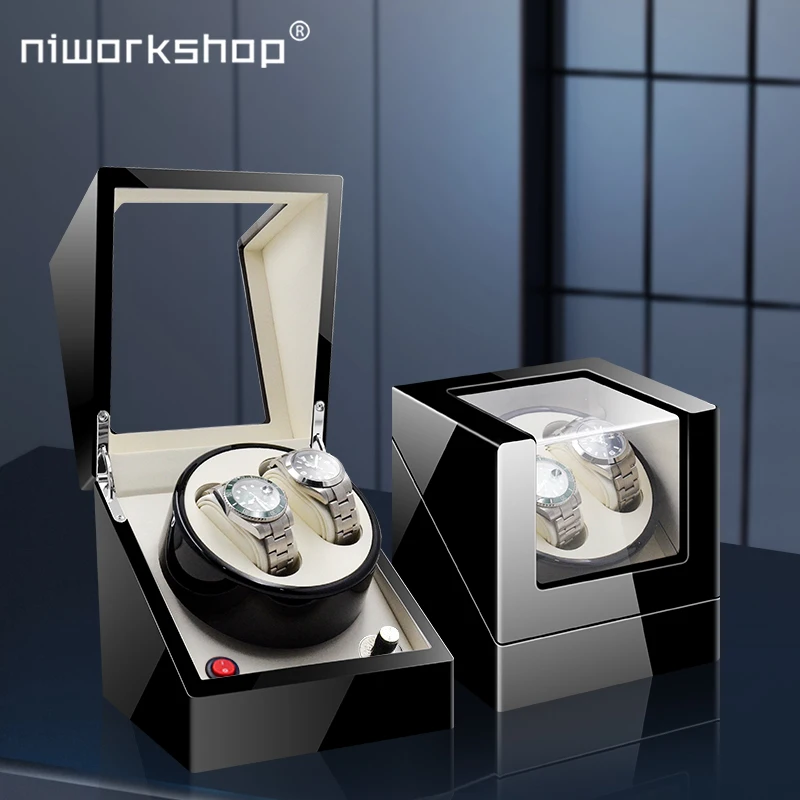
Will running my winder 24/7 damage the motor?
Continuous operation accelerates wear on motor components. Most automatic watches maintain proper winding with 8-12 hours of daily rotation. Programming rest periods extends motor life while still keeping watches wound. Understanding how fast watch winders should spin helps optimize settings for both watch maintenance and motor preservation.
For collectors starting with a single timepiece, our single watch winder collection offers reliable options with various motor technologies to match your specific needs.

